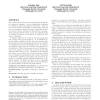Free Online Productivity Tools
i2Speak
i2Symbol
i2OCR
iTex2Img
iWeb2Print
iWeb2Shot
i2Type
iPdf2Split
iPdf2Merge
i2Bopomofo
i2Arabic
i2Style
i2Image
i2PDF
iLatex2Rtf
Sci2ools
KDD
2007
ACM
2007
ACM
Detecting anomalous records in categorical datasets
We consider the problem of detecting anomalies in high arity categorical datasets. In most applications, anomalies are defined as data points that are 'abnormal'. Quite often we have access to data which consists mostly of normal records, along with a small percentage of unlabelled anomalous records. We are interested in the problem of unsupervised anomaly detection, where we use the unlabelled data for training, and detect records that do not follow the definition of normality. A standard approach is to create a model of normal data, and compare test records against it. A probabilistic approach builds a likelihood model from the training data. Records are tested for anomalousness based on the complete record likelihood given the probability model. For categorical attributes, bayes nets give a standard representation of the likelihood. While this approach is good at finding outliers in the dataset, it often tends to detect records with attribute values that are rare. Sometim...
Arity Categorical Datasets | Complete Record Likelihood | Data Mining | KDD 2007 | Unlabelled Anomalous Records |
Related Content
| Added | 30 Nov 2009 |
| Updated | 30 Nov 2009 |
| Type | Conference |
| Year | 2007 |
| Where | KDD |
| Authors | Kaustav Das, Jeff G. Schneider |
Comments (0)

